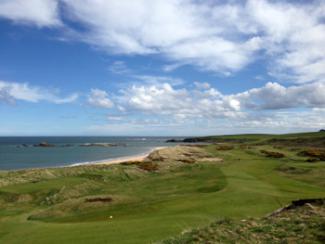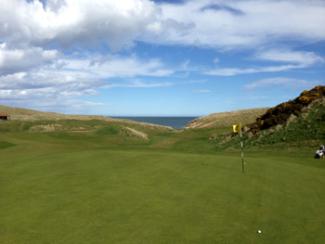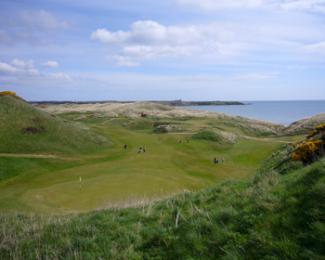Featured Golf News
Crossing Scotland, Day 5 - Blind Shots
From the sublime to the ridiculous and fun, from Trump International Golf Links to Cruden Bay, all in a couple of day's work crossing Scotland en route to the Highlands.

The Back Nine at Cruden Bay as Seen
from the 10th Tee (Photo by Tom Cade)
Way back in 2000, at the debuting Kingsbarns course near St. Andrews, I was fortunate as a single to join a group that included Herb Kohler, the toilet czar who built Whistling Straits.
Each summer Kohler would spend two weeks playing golf in Scotland and Ireland with his buddy, designer Pete Dye. I asked Kohler what he and Dye considered as the two best courses everyone didn't know. Without hesitation, he named Carne in Ireland and Cruden Bay in Scotland.
Situated not far from Trump International, Cruden Bay enjoys some of the same enormous dunes along the North Sea, but beyond that there are no comparisons. Cruden Bay is a quirky and historic outpost of golf, actually designed in the 1890s by Old Tom Morris as part of a resort for the Great North of Scotland Railway.

The Par-4 8th at Cruden Bay
After our round the general manager, Les, showed us a film clip he had gleaned from the national library of Harry Vardon and Ted Ray playing Cruden Bay.
In the 1920s, the "Brighton of the North," as Cruden Bay was called, was visited by many leading socialites and barons of industry. But that was a different time. The railroad shut down following World War II and the lavish hotel atop the hill was demolished. The course prevailed, however, with many of the same greens Old Tom Morris had designed.
The building of the extravagant Trump course has brought new attention to a very old place. For those willing to leave the confines of St. Andrews, there has developed a sort of gorse golf trail - St. Andrews, Carnoustie, Royal Aberdeen, Trump International, Cruden Bay and, even farther north, Nairn, Castle Stuart and, finally, Royal Dornoch.

Some of the Towering Dunes at Cruden Bay
With the soaring dunes, views of the beach, Bay of Cruden and even Slains Castle as a backdrop, there's nothing quite like Cruden Bay. The castle, by the way, was the model used by Bram Stoker when he wrote "Dracula."
Not that the course is creepy, but it is crazy, with seven blind holes. Let us count the quirkiness:
• You walk off one green to hit your next tee shot directly over it.
• Or better yet, try to play a 200-yard dogleg par-3 with no green in sight. Or follow that hole with another par-3 in which you can't see the green. Back-to-back blind shots.
• Or tell the group behind you that you're off the green by ringing a bell on top of a dune by pulling a 100-foot-long rope.

Author Blaine Newnham on the 9th Tee
Overlooking the Bay of Cruden
• Or hit blindly to a "basin" green. Or play a shot off the beach.
• Or stand there taking pictures from atop a dune that also serves as the ninth tee.
• Or be seduced in the clubhouse after the round to try Stovies, an unsightly pile of meat, potatoes and onions that tastes better than it looks. Much better.
We caught an afternoon with the wind howling, as if often does in these parts. You measure wind speeds not in miles per hour, but by club selection. This wind was four clubs. In other words, if you'd hit a 7-iron on a calm day, you'd hit 3-iron today. As if you actually still have a 3-iron.
Quickly, a par-4 becomes a par-5, and a par-5 a par-6. When Vardon and Ray played Cruden Bay, it was par 78 at just about 6,200 yards, where we played it. It's all about timing and perspective.
We turned into the wind on No. 4 and played the next seven holes with our stocking caps pulled down. You quickly understand the meaning of the phrase, "Swing easy when it's breezy." The harder you swing, the higher the ball goes, and high is not what you want in these conditions.
Cruden Bay is a heck of a golf course. The drop-in charge is $150 for all-day play. Trump International is twice that much and, in my opinion, half the fun.
Blaine Newnham has covered golf for 50 years. He still cherishes the memory of following Ben Hogan for 18 holes during the first round of the 1966 U.S. Open at the Olympic Club in San Francisco. He worked then for the Oakland Tribune, where he covered the Oakland Raiders during the first three seasons of head coach John Madden. Blaine moved on to Eugene, Ore., in 1971 as sports editor and columnist, covering the 1972 Olympic Games in Munich. He covered five Olympics all together - Mexico City, Munich, Los Angeles, Seoul, and Athens - before retiring in early 2005 from the Seattle Times. He covered his first Masters in 1987 when Larry Mize chipped in to beat Greg Norman, and his last in 2005 when Tiger Woods chip dramatically teetered on the lip at No. 16 and rolled in. He saw Woods' four straight major wins in 2000 and 2001, and Payne Stewart's par putt to win the U.S. Open at Pinehurst. In 2005, Blaine received the Northwest Golf Media Association's Distinguished Service Award. He and his wife, Joanna, live in Indianola, Wash., where the Dungeness crabs outnumber the people.
Story Options
 |
Print this Story |
